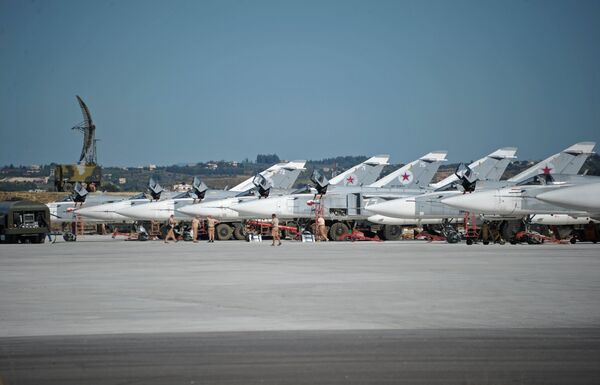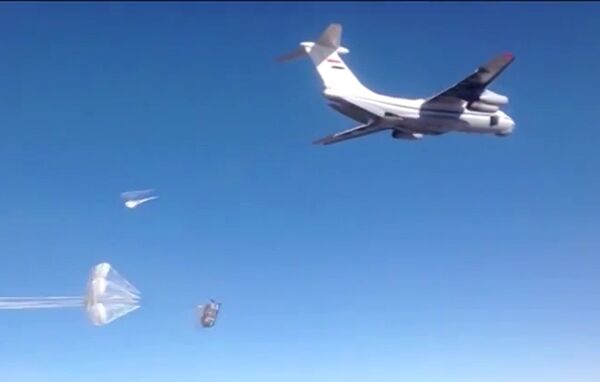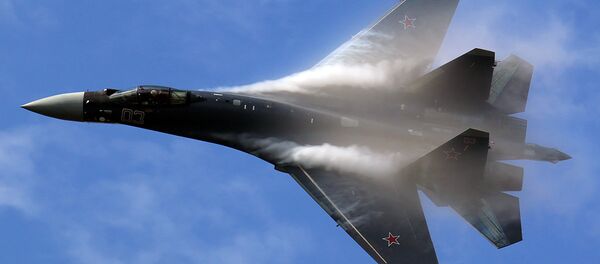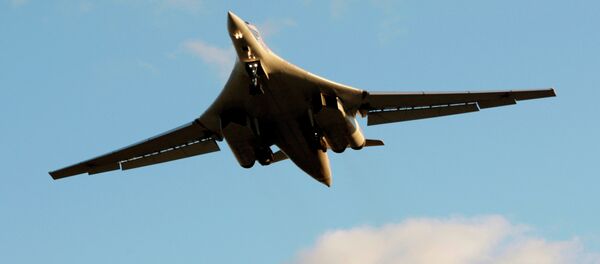Naturally, with the passage of time, the legendary warplanes have received all sorts of upgrades, some becoming almost unrecognizable compared to the characteristics and capabilities of their forefathers. The upgrades include modern instrumentation, more powerful engines, upgraded weapons systems, and sometimes even changes to the air frame. Still, in the case of these planes, the well-known adage of 'if it ain't broke, don't fix it' definitely seems to hold true.
With that in mind, looking back at the designs which continue to serve the motherland, some now over half-a-century after their initial introduction, Russian journalist, novelist and military analyst Vladimir Tuchkov wrote a piece for the independent Russian newspaper Svobodnaya Pressa on the subject.
Tuchkov's criteria? Simple. The aircraft in the list were those which entered into service before 1980.
The Russian 'Bear'
Arguably the most important veteran, the journalist writes, "is Russia's Tu-95 long-range strategic bomber, which made its maiden flight on November 12, 1952. The aircraft entered into the Air Force in April 1956. Initially, this plane was our country's only nuclear-capable deterrent, able to make flights across the ocean to strike the USA. Intercontinental ballistic missiles appeared later."

"In strategic terms, the Tu-95, which NATO has dubbed the 'Bear', is comparable to the American B-52. Technically speaking, the Tupolev Design Bureau was able to solve the necessary design tasks independently. Whereas the American plane features 8 turbojet engines, the Bear is able to take a 12 ton payload across the Atlantic with only four turboprops. At the same time, while its maximum top speed is 100 km/h lower, it matches its American vis-à-vis in cruising speed."
"However, by the end of the 1950s, the situation changed significantly, thanks to the continuing development of fighter technology. The B-52's altitude could no longer guarantee its safety, and powerful anti-aircraft missiles began to appear. As a result, the comparatively lower speed and lower flight altitude of our machine was no longer of such great importance in terms of assuring strategic security."
"The latest modification of the bomber – the Tu-95MS, began entering into service in 1983. This aircraft was equipped with Kh-55 cruise missiles, capable of carrying a nuclear payload, with a range of [up to] 3,000 km." 2013 saw the arrival of the Kh-102, with a range of 5,500 km. The missile's extreme range and high speed, Tuchkov noted, effectively means that the plane does not even have to approach the zone of the enemy's air defenses.
Terrorists' Nightmare in Syria
"In terms of fighters and tactical aviation, Russian aircraft are, for the most part, considerably younger than their American counterparts. The US Air Force continues to operate three planes which entered into service before 1980 – fighters including the F-15 Eagle and the F-16 Fighting Falcon, and the A-10 Thunderbolt II ground attack aircraft. In numerical terms, these planes make up the US Air Force's main strike capability."

"In Russia, the only old-timer left [among tactical aviation] is the Su-24 frontline bomber, which made its maiden flight on January 17, 1970 and was introduced into service in 1975."
The aircraft, Tuchkov recalls, "was a breakthrough with its variable-sweep wing design. Its main advantage was the ability to carry out low-altitude terrain-following supersonic flight, which contributed to an ability to successfully overcome enemy air defenses."
"Furthermore, the bomber featured the innovation of the powerful 'Puma' navigation and sighting (nav/attack) system. The system weighed half-a-ton, and demanded great resourcefulness from designers to put it on board the light aircraft. However, the cost was worth it, and the Puma system provided not only for safe low-level flight, but also allowed for the application of precise strikes by the Kh-23 guided missile on low-contrast targets. Moreover, the Kh-28 missile was capable of suppressing enemy radar."
"Today, having undergone a deep modernization, the Su-24 has become the Su-24M. All its avionics have been upgraded. The bomber received new missile and bomb systems. Today it is this bomber which strikes at the positions of the terrorists in Syria."
Features a 615 km combat radius, the Su-24M has a low-altitude maximum speed of 1,400 km/h (1,700 km/h at higher altitudes), a 8,000 kg maximum payload, and 8 brackets on which to attach missiles and precision bombs.
The Airborne's Friend
"Veteran aircraft dominate the Russian military's fleet of transport aircraft," Tuchkov recalled. "For the most part, they were designed by Ukraine's Antonov Design Bureau, which specialized in this area of military aviation. In connection with Russia's recent 'divorce' from Ukraine, these machines began to be replaced by new designs from Ilyushin."
The first Antonov design the analyst looks at is the An-12. "The An-12 military transport plane made its maiden flight in 1957. Only a year-and-a-half later, the plane began entering into service in the Air Force. The plane had a universal design, and has also been used in civil aviation, but the machine was found to be most effective and desirable among the Airborne forces. It was the first Soviet aircraft which allowed the army to perform operations featuring the mass dropping of paratroopers and armored vehicles, carrying 60 men or two armored personnel carriers."
"In its own time, the AN-12 was a very powerful transport aircraft, featuring 4 turboprop engines of 4,250 hp each. With a payload of 20 tons, this aircraft had very decent flight characteristics, with a maximum/cruising speed of 660 km/h and 570 km/h, respectively, a 10,000 m flight ceiling, and a ferrying range of 5,500 km." The plane's rear turret featured 2x22-mm cannon, and a compartment which could hold 100-500 kg bombs.
Truck With Wings
"The An-26," Tuchkov noted, "appeared following the An-12 and entered service in 1973, and had more modest capabilities, the twin-turboprop engine machine capable of lifting a 5,500 kg payload. Initially, the An-26 was not intended for use in combat, nor for use by the airborne forces. Instead, the mass-produced plane (about 1,500 were built) became a means to transport cargo and personnel, assigned for the wartime role of delivering ammunition and evacuating the wounded. In other words, it is a regular truck with wings. A passenger version was also available to comfortably transport high-ranking officers."

Heavy Duty
"In 1969, the ranks of the Soviet Union's airborne transport forces began to be stocked with the heavyweight record-holding An-22 'Antei'. This was the Soviet Union's first wide-body turboprop aircraft, and then the only heavyweight plane in the world capable of taking off and landing on rough, unpaved airstrips. All in all, up to 1976, 68 machines were produced at the Tashkent Aviation Plant."
The An-22, Tuchkov recounted, is capable of lifting a 60 ton payload, and can hold 290 soldiers, 202 wounded on stretchers, or 160 paratroopers. Maximum speed: 650 km/h. Range: 5225 km. Flight ceiling: 9,000 m. The dimensions of this giant are as follows: length: 57 m, height: 12.5 m, wingspan: 64 m.
Incidentally, "the Antei became the Soviet Union's first transport aircraft in to use automation and mechanization for loading and unloading operations, and featured the possibility of transporting goods suspended under the plane."
I Spy With My Little Eye
"The Il-20 electronic intelligence aircraft made its maiden flight on March 21, 1968, and was introduced into service a year later. Created on the basis of the passenger turboprop Il-18, the Il-20 features more powerful engines and a larger fuel capacity."

"The aircraft's competencies include electronic intelligence, photographic reconnaissance, and radio interception. The plane is equipped with all sorts of spying equipment, has a satellite connection, and undergoes period modernization. 20 aircraft have been produced, and they are listed under the Forces of Central Subordination [reporting directly to the Air Force Headquarters]. At present, the Ilyushin Design Bureau is getting ready for another modernization. "
Forever Young
"The production of the An-22 was ended fairly quickly, due to the fact that it became necessary to free production capacity to build a more promising aircraft from the Ilyushin Design Bureau – the Il-76. The Ilyushin had a smaller carrying capacity, but a state commission had concluded that its turbojet engines were preferable in exploitation to the An-22's turboprops. Moreover, the Il-76 had a higher flight speed."
Adopted in 1976, "the Il-76 had an initial lift capacity of 40 tons, which has since been upped to 60 tons."
Tuchkov recalled that "from the very first years of operation, the plane set records which greatly exceeded its formal characteristics. In July 1975, flying the first series production Il-76, test pilot Y.I. Bernikov took a cargo weighing 70,121 kg up to an altitude of 11,875 m. The same day, test pilot A.M. Tyuryumin reached a record average speed of 857.65 km/h with a load of 70 tons a distance of 1,000 km."
"As far as the latest modification, the Il-76-MD-90A, is concerned, it constitutes a deep modernization, and is factually a new aircraft. The first prototype took to the skies in 2012, and the first plane was completed in 2014."

"The Il-76-MD-90A," the military analyst noted, "is capable not only of delivering cargoes of increased size and weight, and of carrying out the parachuting deployment of troops and equipment, but, like a bomber, can 'fend for itself' in a combat zone. The plane features 2x23-mm cannons, capable of finding their targets using both a conventional optical sights and radar. It is also equipped with electronic countermeasures and flares. The plane also has four brackets which can be equipped with missiles and bombs; these can also be used as external fuel tanks."
"Today," Tuchkov noted, "the Il-76 is the main aircraft of the Russian Air Force's Military Transport Aviation Command, operating about 120 birds of various modifications. 39 Il-76-MD-90As are on order."






